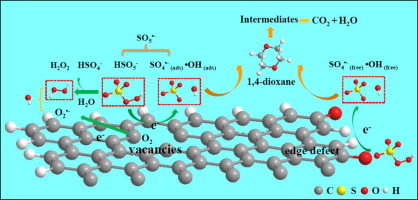Chemical Engineering Journal ( IF 13.3 ) Pub Date : 2019-03-26 , DOI: 10.1016/j.cej.2019.03.235 Da Ouyang , Yun Chen , Jingchun Yan , Linbo Qian , Lu Han , Mengfang Chen

|
Carbonaceous materials have been emerged as promising metal-free catalysts to activate peroxymonosulfate (PMS) for the degradation of organic contaminants. In the present study, a low-cost carbonaceous material, pine needle biochar was prepared under the oxygen limited pyrolyzation process and applied to activate PMS for the catalytic degradation of potentially carcinogenic 1,4-dioxane. Based on the batch experiments, the pyrolysis temperature has a significant influence on the potency of biochar to activate PMS. Within the biochar/PMS system, the degradation efficiencies of 1,4-dioxane were increased from 4.1 to 84.2% when the biochar pyrolysis temperatures were increased from 300 °C to 800 °C. Electron paramagnetic resonance (EPR) study and the quenching experiment verified that the dominant free radical within the system of biochar/PMS was OH. The EPR combined X-ray photoelectron spectroscopy (XPS), Fourier transform infrared (FTIR) and Raman analysis implied that the defect of biochar contributed to the generation of SO4
− and
OH and high pyrolysis temperatures would eliminate the excess of oxygen functional groups in biochar, which could modulate and transform sp3 carbons, generating more defect structures, therefore, enhancing the activation potency of biochar towards PMS. Simultaneously, five major intermediates were identified and three possible degradation pathways were proposed in this study. In addition, 71.4% and 57.5% of 1,4-dioxane removal rates were achieved in 1,4-dioxane contaminated tap water and groundwater, indicating that biochar activating PMS is a promising technique for the remediation of 1,4-dioxane contaminated water.
中文翻译:

生物炭过氧单硫酸盐的活化机理对1,4-二恶烷的催化降解:生物炭缺陷结构的重要作用
碳质材料已经成为有前途的无金属催化剂,可以活化过氧单硫酸盐(PMS)来降解有机污染物。在本研究中,在限氧热解过程中制备了一种低成本的含碳材料松针生物炭,并将其用于激活PMS以催化降解可能致癌的1,4-二恶烷。根据分批实验,热解温度对生物炭激活PMS的能力有重要影响。在生物炭/ PMS系统中,当生物炭热解温度从300°C增加到800°C时,1,4-二恶烷的降解效率从4.1提高到84.2%。电子顺磁共振(EPR)研究和猝灭实验证明,biochar / PMS系统中的主要自由基为哦。的EPR组合的X射线光电子能谱法(XPS),傅立叶变换红外(FTIR)和拉曼分析暗示,生物炭的促成的SO产生的缺陷4
-和
OH和高的热解温度将消除过量的氧官能团的生物炭,可以调节和转化sp 3碳,产生更多的缺陷结构,因此,增强了生物炭对PMS的活化能力。同时,鉴定了五个主要中间体,并提出了三种可能的降解途径。此外,在1,4-二恶烷污染的自来水和地下水中,分别达到1,1.4-二恶烷去除率的71.4%和57.5%,这表明生物炭活化PMS是修复1,4-二恶烷污染的水的有前途的技术。 。































 京公网安备 11010802027423号
京公网安备 11010802027423号